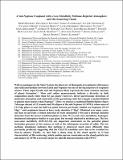| dc.contributor.author | Benneke, Björn | |
| dc.contributor.author | Knutson, Heather A. | |
| dc.contributor.author | Lothringer, Joshua | |
| dc.contributor.author | Crossfield, Ian Jm | |
| dc.contributor.author | Moses, Julianne I. | |
| dc.contributor.author | Morley, Caroline | |
| dc.contributor.author | Kreidberg, Laura | |
| dc.contributor.author | Fulton, Benjamin J. | |
| dc.contributor.author | Dragomir, Diana | |
| dc.contributor.author | Howard, Andrew W. | |
| dc.contributor.author | Wong, Ian | |
| dc.contributor.author | Désert, Jean-Michel | |
| dc.contributor.author | McCullough, Peter R. | |
| dc.contributor.author | Kempton, Eliza M.-R. | |
| dc.contributor.author | Fortney, Jonathan | |
| dc.contributor.author | Gilliland, Ronald | |
| dc.contributor.author | Deming, Drake | |
| dc.contributor.author | Kammer, Joshua | |
| dc.date.accessioned | 2020-10-28T20:17:18Z | |
| dc.date.available | 2020-10-28T20:17:18Z | |
| dc.date.issued | 2019-07 | |
| dc.date.submitted | 2018-12 | |
| dc.identifier.issn | 2397-3366 | |
| dc.identifier.uri | https://hdl.handle.net/1721.1/128229 | |
| dc.description.abstract | With no analogues in the Solar System, the discovery of thousands of exoplanets with masses and radii intermediate between Earth and Neptune was one of the big surprises of exoplanet science. These super-Earths and sub-Neptunes probably represent the most common outcome of planet formation1,2. Mass and radius measurements indicate a diversity in bulk composition much wider than for gas giants3; however, direct spectroscopic detections of molecular absorption and constraints on the gas mixing ratios have largely remained limited to planets more massive than Neptune4–6. Here we analyse a combined Hubble/Spitzer Space Telescope dataset of 12 transits and 20 eclipses of the sub-Neptune exoplanet GJ 3470 b, whose mass of 12.6 M⊕ places it near the halfway point between previously studied Neptune-like exoplanets (22–23 M⊕)5–7 and exoplanets known to have rocky densities (7 M⊕)8. Obtained over many years, our dataset provides a robust detection of water absorption (>5σ) and a thermal emission detection from the lowest irradiated planet to date. We reveal a low-metallicity, hydrogen-dominated atmosphere similar to that of a gas giant, but strongly depleted in methane gas. The low metallicity (O/H = 0.2–18.0) sets important constraints on the potential planet formation processes at low masses as well as the subsequent accretion of solids. The low methane abundance indicates that methane is destroyed much more efficiently than previously predicted, suggesting that the CH4/CO transition curve has to be revisited for close-in planets. Finally, we also find a sharp drop in the cloud opacity at 2–3 µm, characteristic of Mie scattering, which enables narrow constraints on the cloud particle size and makes GJ 3470 b a key target for mid-infrared characterization with the James Webb Space Telescope. | en_US |
| dc.language.iso | en | |
| dc.publisher | Springer Science and Business Media LLC | en_US |
| dc.relation.isversionof | http://dx.doi.org/10.1038/s41550-019-0800-5 | en_US |
| dc.rights | Article is made available in accordance with the publisher's policy and may be subject to US copyright law. Please refer to the publisher's site for terms of use. | en_US |
| dc.source | arXiv | en_US |
| dc.title | A sub-Neptune exoplanet with a low-metallicity methane-depleted atmosphere and Mie-scattering clouds | en_US |
| dc.type | Article | en_US |
| dc.identifier.citation | Benneke, Björn et al. "A sub-Neptune exoplanet with a low-metallicity methane-depleted atmosphere and Mie-scattering clouds." Nature Astronomy 3, 9 (July 2019): 813–821 © 2019 The Author(s) | en_US |
| dc.contributor.department | Massachusetts Institute of Technology. Department of Earth, Atmospheric, and Planetary Sciences | en_US |
| dc.contributor.department | Massachusetts Institute of Technology. Department of Physics | en_US |
| dc.contributor.department | MIT Kavli Institute for Astrophysics and Space Research | en_US |
| dc.relation.journal | Nature Astronomy | en_US |
| dc.eprint.version | Author's final manuscript | en_US |
| dc.type.uri | http://purl.org/eprint/type/JournalArticle | en_US |
| eprint.status | http://purl.org/eprint/status/PeerReviewed | en_US |
| dc.date.updated | 2020-10-20T14:39:56Z | |
| dspace.orderedauthors | Benneke, B; Knutson, HA; Lothringer, J; Crossfield, IJM; Moses, JI; Morley, C; Kreidberg, L; Fulton, BJ; Dragomir, D; Howard, AW; Wong, I; Désert, J-M; McCullough, PR; Kempton, EM-R; Fortney, J; Gilliland, R; Deming, D; Kammer, J | en_US |
| dspace.date.submission | 2020-10-20T14:40:07Z | |
| mit.journal.volume | 3 | en_US |
| mit.journal.issue | 9 | en_US |
| mit.license | PUBLISHER_POLICY | |
| mit.metadata.status | Complete | |
